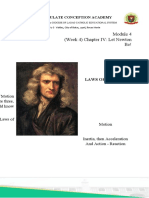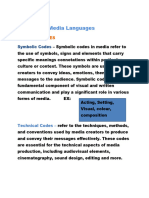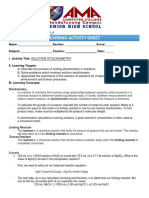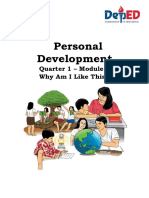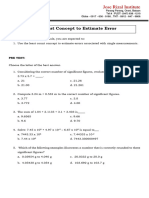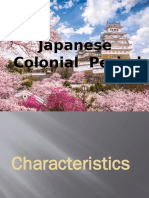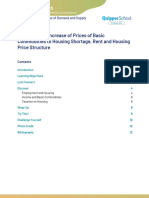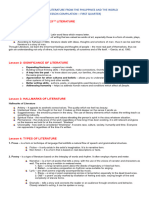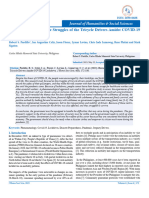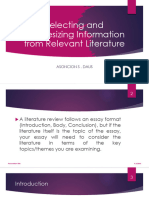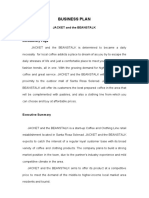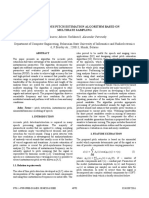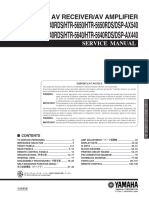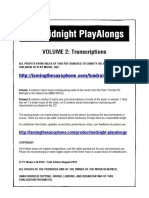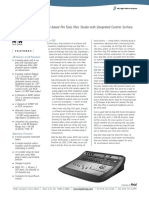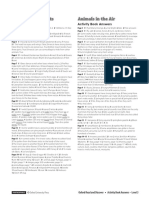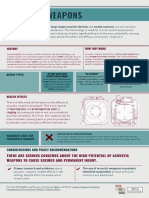Additional Notes For Cpar
Uploaded by
Jacqueline RamosAdditional Notes For Cpar
Uploaded by
Jacqueline RamosADDITIONAL NOTES FOR CPAR
Subject and Elements of Arts
By definition, a subject or topic is any person, animal, thing, or issue that is described or represented in a
work. A subject is different from theme or content. The theme is the recurring idea or element in a work of
art. It refers to the ideas, thoughts, and feelings of the artist.
Anything can be considered a subject in the arts, from the simpler idea, or an object to the most complex
thing. In painting, artworks with subjects that are recognizable are called realistic, representational, or
objective art. Therefore, those that are not difficult to recognize are termed non-representational or non-
objective art.
Contemporary artists have their own styles. Authorities in art are one in their view that different
methods/styles used by the artist in presenting the art subjects are the following: any single style or
combination, such as realism, distortion, abstractions, symbolism and non-objectivism.
Realism – the attempt to portray the subject as it is. The realist tries to be very objective. The
artist’s main objective is to describe as accurately and as honestly as possible what is observed
through his senses.
Distortion – The artist uses his or her imagination and alters the subject according to his or her own
desire.
Abstraction – The artist breaks apart a subject and rearranges it in a different manner. Pablo
Picasso innovated this style in 1900s.
Non-objectivism – This is described as an art form which has totally no subject at all. Simply, it is
an interplay of pure elements like line, shape, color, and so on. Artists of this style is conscious that
he is no longer subject to Western ideas, concepts and forms.
Elements of Arts
These elements are the basic tools of expression in any art form. They can be found in nature and in a
man-made environment. Filipino artists use, arrange, and manipulate them to express feelings or mood and
to convey their message to the viewers, listeners or readers.
Space – it can be defined as a void, an emptiness which can either be positive or negative. The
positive space refers to a space enclosed in a shape, while the negative space denotes the opposite. It
can also be referred to as an interval or pause. In literature, it is the pause between words, whereas in
music, it is the interval between notes.
Line – It is the extension of a point, a short or long mark drawn or curved on a surface. It suggests: a.
direction: vertical, horizontal , diagonal; b. character: curved, jagged, series of dots or broken lines
In performing arts and literary arts, a line is described differently. In theater, a line may refer to the
script of the actor and in a dance, it is the series of steps that a dancer makes.
Shape and form – When the ends of a line meet, they form a shape. It can also mean geometric
(angular) or organic (curvy). Form is related to shape yet, is still different. It is an enclosed line, a figure
separate from its background. However, the shape is two-dimensional, while form is three-dimensional.
For example, the square is an example of shape; the cube is a form. The circle is a shape, and the
sphere is a form.
Color – The most interesting and striking art element is the color. Color creates a mood or tone, such
as red for passion, anger or love, blue for peace, nobility or sadness and yellow for gaiety, innocence
or jealousy. Color also varies from dull to bright, depending on its intensity. In music, the intensity can
also mean loudness or softness of a sound.
Value – It is the degree of lightness or darkness of a color. In music, it is called pitch. It is the highness
or lowness of a tone. The tone color or timbre refers to the quality of the sound. Value also suggests an
atmosphere or mood, and it is also found in other art forms just like a strong contrast suggests strong
emotional responses especially in writing.
Texture – It is the surface of an art work, It can be actual or tactile. It can be touched or it can be
simulated or illusory or it can be seen and not felt. In the field of music, texture is the quality or style of
composition. The sounds from different musical instruments allow one to hear texture in sound.
Principles of Design
It is important to know the principles of designs to be able to evaluate the art value. Sometimes, it is also
called the organization of elements. These principles are tools for organizing the elements of art to produce
a unified and harmonious design, composition, and/or performance.
Harmony – it is the wholeness of the design, the pleasing arrangement of parts and the agreement
between parts of a composition, resulting in a unified whole.
Variety – refers to the variety/kinds/differences in all of our surroundings. This is necessary to prevent
monotony and add to uniformity.
Rhythm – or beat is the regular, repeated pattern in the elements of art
Proportion – means the relationship between and among the work of art
Balance – it is the principle that deals with equality. To be specific, it can either be formal or informal
Movement – in dance, it is the important principle in choreography and in theater arts. It also conveys
feelings and emotions through bodily movement of a dancer or stage performer
Emphasis or subordination – it is a way to give importance or dominance to a unit or an area
These elements and principles are sued by many artists to create their art works. With the same elements
and principles, we can analyze or critique an art work. Of course, we are not experts nor professionals. But
being able to analyze an art work, it gives us at least a slight understanding of what the work is about, what
the artist was feeling when he created it and the differences each of us have on our interpretation of the
artwork
You might also like
- Hammond X-77 and X-77 GT Service Manual2 OCRNo ratings yetHammond X-77 and X-77 GT Service Manual2 OCR161 pages
- Social and Cultural Institutions: Grade 12-Group ANo ratings yetSocial and Cultural Institutions: Grade 12-Group A40 pages
- Modern Era: Module: Hcma22 - Contemporary Music and ArtsNo ratings yetModern Era: Module: Hcma22 - Contemporary Music and Arts10 pages
- Learning Activity Sheet: General Chemistry 2 - W - 7No ratings yetLearning Activity Sheet: General Chemistry 2 - W - 73 pages
- Edzel Marie de La Cruz Grade 12 HUMSS Diplomacy: Creative Nonfiction Quarter 4 Week 1100% (1)Edzel Marie de La Cruz Grade 12 HUMSS Diplomacy: Creative Nonfiction Quarter 4 Week 17 pages
- Hydrometeorological Hazards For StudentsNo ratings yetHydrometeorological Hazards For Students30 pages
- 21 Century Literature From The Philippines and The WorldNo ratings yet21 Century Literature From The Philippines and The World23 pages
- Chapter Xii: Social Problems and Social ChangeNo ratings yetChapter Xii: Social Problems and Social Change10 pages
- AEC - 12 - Q1 - 0304 - SG - The Impact of Increase of Prices of Basic Commodities To Housing Shortage, Rent and Housing Price StructureNo ratings yetAEC - 12 - Q1 - 0304 - SG - The Impact of Increase of Prices of Basic Commodities To Housing Shortage, Rent and Housing Price Structure16 pages
- Contemporary Arts Form and Practices From The Regions of The Philippines100% (1)Contemporary Arts Form and Practices From The Regions of The Philippines3 pages
- YES NO: Does Critical Reading or Evaluative Reading Can Be A Form of Reading For Pleasure?No ratings yetYES NO: Does Critical Reading or Evaluative Reading Can Be A Form of Reading For Pleasure?7 pages
- Cpar Week 5 Contemporary Philippine Arts From The Regions SlmsNo ratings yetCpar Week 5 Contemporary Philippine Arts From The Regions Slms25 pages
- Core Ucsp11 12 Semi II Clas1 the-scope-Of-Anthropology-sociology-And-political-science Final (3) - Rhea Ann NavillaNo ratings yetCore Ucsp11 12 Semi II Clas1 the-scope-Of-Anthropology-sociology-And-political-science Final (3) - Rhea Ann Navilla15 pages
- II. Study Background .. A. Brief History of The Company B. Mission and Vision C. Product/ Service OfferingsNo ratings yetII. Study Background .. A. Brief History of The Company B. Mission and Vision C. Product/ Service Offerings31 pages
- PHILOSOPHY - ANALYTIC TRADITION Report (LIGTAS, ELMER JUDE D.)No ratings yetPHILOSOPHY - ANALYTIC TRADITION Report (LIGTAS, ELMER JUDE D.)22 pages
- Heroes of The Road The Struggles of The Tricycle Drivers Amidst Covid19 LockdownNo ratings yetHeroes of The Road The Struggles of The Tricycle Drivers Amidst Covid19 Lockdown9 pages
- Writing A Review Response or Reaction Paper 1No ratings yetWriting A Review Response or Reaction Paper 120 pages
- "Man Danced Originally To Supplicate The Gods On All Important Occasions in Life." (Kraus and Gaufman, 1981)No ratings yet"Man Danced Originally To Supplicate The Gods On All Important Occasions in Life." (Kraus and Gaufman, 1981)2 pages
- Understanding Culture and Society: Lesson IINo ratings yetUnderstanding Culture and Society: Lesson II11 pages
- General Chemistry 1 Activity Sheet Quarter 2-MELC 12 Week 6No ratings yetGeneral Chemistry 1 Activity Sheet Quarter 2-MELC 12 Week 69 pages
- Attracted To Intermolecular Forces Part A: Frayer Model of Liquids and SolidsNo ratings yetAttracted To Intermolecular Forces Part A: Frayer Model of Liquids and Solids6 pages
- Week 11: Media and Information LiteracyNo ratings yetWeek 11: Media and Information Literacy10 pages
- Media Information Languages: Prepared By: MARK JHON C. OXILLONo ratings yetMedia Information Languages: Prepared By: MARK JHON C. OXILLO81 pages
- I Am Sharing 'The Elements of Arts and Principles of Design' With YouNo ratings yetI Am Sharing 'The Elements of Arts and Principles of Design' With You24 pages
- Jacqueline Ramos Manuscript Chapter 1-5No ratings yetJacqueline Ramos Manuscript Chapter 1-5254 pages
- EDITED CHAPTER 1-3_JACQUELINE RAMOS MAED ENGLISHNo ratings yetEDITED CHAPTER 1-3_JACQUELINE RAMOS MAED ENGLISH95 pages
- Business Plan: Jacket and The BeanstalkNo ratings yetBusiness Plan: Jacket and The Beanstalk11 pages
- Instantaneous Pitch Estimation Algorithm Based On Multirate SamplingNo ratings yetInstantaneous Pitch Estimation Algorithm Based On Multirate Sampling5 pages
- St. Xavier's High School: Sector 49, GurgaonNo ratings yetSt. Xavier's High School: Sector 49, Gurgaon2 pages
- Pete Thomas - The Midnight PlayAlongs Vol.2 (Eb, BB, C, Bass)No ratings yetPete Thomas - The Midnight PlayAlongs Vol.2 (Eb, BB, C, Bass)37 pages
- Sound: Name: Bhavyata Upadhyay Roll No: 03596702119No ratings yetSound: Name: Bhavyata Upadhyay Roll No: 0359670211911 pages
- Handel - Movement Vi From Water Music Suite Teacher Notes100% (1)Handel - Movement Vi From Water Music Suite Teacher Notes14 pages
- Direct Field and Reverberant Chamber Acoustic Test ComparisonsNo ratings yetDirect Field and Reverberant Chamber Acoustic Test Comparisons24 pages
- A Steel Guitar Master Class From Jerry Byrd100% (3)A Steel Guitar Master Class From Jerry Byrd3 pages
- Turning The Hiram Key Robert Lomas download100% (1)Turning The Hiram Key Robert Lomas download86 pages




